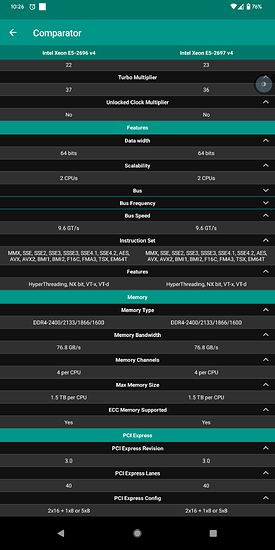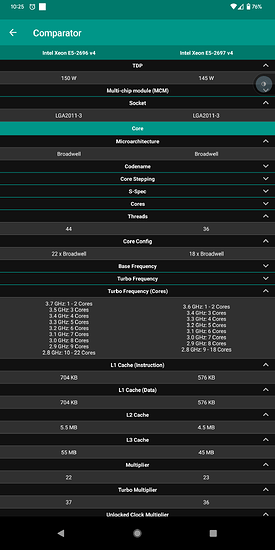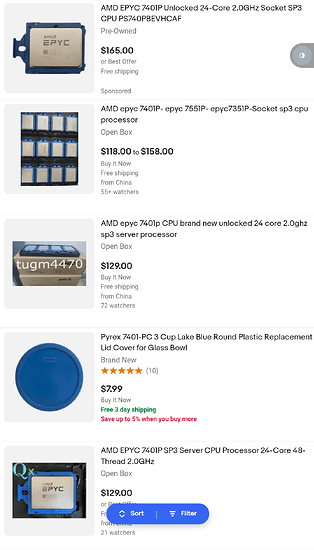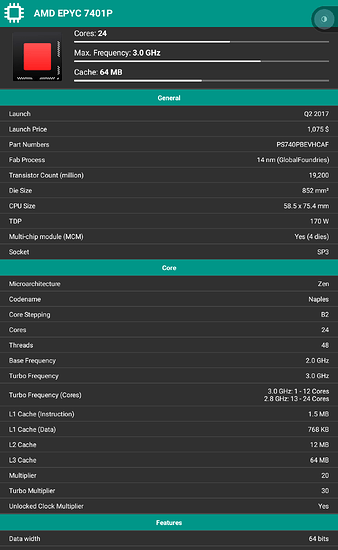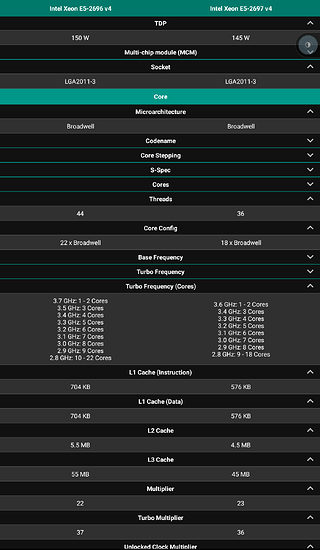Hello…
Do you think E5-2696v4 22 core Xeon significantly better than E5-2697v4 18 core ?
22-cores E5-2696v4 is more expensive about 80% than 18 -cores E5-2697v4, do you think its worth it ?
Do you mean E5-2697 v4 VS E5-2699 v4?
Guess it really depends what you want to use it for but IMO old generation server flagship CPUs like that are never worth it for anyone except those that aren’t concerned about cost…
Edit: looks like the 2696 and 2699 have same base frequency but there is no arc page for the 2696 which is sus to me
I tend to prefer the lower core count models of older Xeon generations—specifically this generation—because they can better utilize the limited socket power budget to boost more cores/to higher frequencies. If you have a use-case that scales well with additional cores and cache you should should probably be looking at a used EPYC platform instead.
That being said, the 2696v4 has a 150W power budget vs 145W for the 2697v4, so the first thing to confirm is that your platform supports 150W parts—and ideally confirm that the QVL lists this exact part, which was never sold at retail. It also features 55MB of L3 cache vs 45MB for the 2697v4, but with roughly the same base clocks and turbo bins. So sure, if you have a workload that will scale linearly with four more cores and 10MB more cache, and you already have a platform built around this socket, it might make sense to spend a bit extra on this part rather than build a completely new platform.
When I un-hyperconverged (hypoconverged?) my fileserver, I downgraded from a 14-core 2680v4 to an 8-core 2667v4. The 2680v4 was only boosting up to 2.9GHz even though most of the cores were usually idle. The 2667v4 boosts to 3.5GHz under any load and has a good chance of boosting all the way up to 3.6GHz, which might not sound like much but that’s a 20–24% improvement that benefits ZFS checksumming, compression, etc. Just my two cents.
ETA: Here’s what I look at when comparing Xeons.
2696v4 is customizable by system manufacturers so there is no single set of specs for it.
they are old and power hungry.
also the same architecture (broadwell) so the difference in performance with scale by core count.
in this case less than 20% as the extra cores dont turbo. so will run at base.
lastly 80% more expensive?.. im seeing both chips on techbuyer for 90-130 and they are warehouse stock.
I have 2696v4s here.
They boost among highest in SC loads and with 150 W TDP they do that often. Mostly people don’t run these as they require platform that supports 150 W TDP processor which rules out most SuperMicros offerings.
You can disable cores and if I have understood correctly, that won’t affect the ring bus so it should not lower the cache amounts. HCC core power usage is still high on idle.
They’re relative bargain at $100 per ea on eBay.
E: fixed mistake with the TDP, it’s 150 W
Throwing this out there first gen epyc is cheap and has better ipc and performance per watt
Won’t turbo past 3Ghz though, but if all threads are saturated neither will the intel
I use HP DL380 G9 not supermicro… Yes, my motherboard is support 150w CPU… in HP DL380 G9 they need special fan and heatsinks for which they described as “high performance CPU”…
I have a pair of 2697a v4 processors (16 cores, 145 watts, 2.6-3.6 GHz) so there’s another option for you. All core boost for scalar and SSE code is 3.1 GHz; they consistently outperform the 18 core 2697 v4 for that reason.
Good idea too…
This topic was automatically closed 273 days after the last reply. New replies are no longer allowed.
